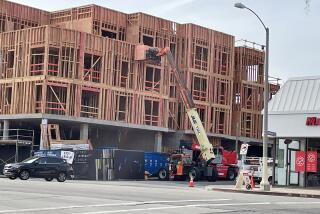Plan Passes Traffic Cost to Builders, Employers
- Share via
In an innovative attempt to ease the crush of traffic, Santa Monica is proposing that employers and developers be charged for employees who drive to work.
Developers who want to build in the city would pay up to $3,000 per rush-hour car trip generated by new projects.
And all businesses already operating in Santa Monica would pay annual “traffic mitigation” fees of $6 to $10 per employee. Those fees could be reduced for employers who institute traffic-saving measures.
The fees are recommended in a 77-page draft Transportation Management Plan commissioned by the city. Copies are being circulated to business groups, neighborhood associations, major companies and public agencies for review.
The plan, more than two years in the making, is expected to go before the Planning Commission and then the City Council for consideration by early next year.
In addition to the fees, the plan calls for urging the estimated 75,000 people who work in Santa Monica to form car pools or van pools and share rides. Employers would be urged to charge for parking as a way to decrease the number of cars being driven to work. Companies would be asked to consider staggering works hours for employees.
The city also proposes subsidizing public bus passes for its employees.
The goal, the plan states, is to increase the number of people per auto by 20% and reduce the number of commuter trips by 15%. According to 1980 figures cited in the report, 54,674 workers commuted to Santa Monica jobs daily in 39,147 private cars.
Efforts to test similar measures elsewhere have not had much success among car-loving Southern Californians. But as traffic jams grow, so does the likelihood people will take heed, city officials say.
“The whole growing problem of traffic congestion is going to start people thinking about doing these kinds of things,” said city senior planner Kenyon Webster.
“And there can be incentives and penalties,” he added. “There are ways to make it work if we are going to deal with traffic problems. Everyone is part of the problem and everyone needs to pitch in.”
The fees are the most controversial element of the plan.
$3,000-per-Trip Fee
Developers would be charged $3,000 for each rush-hour car trip that a new project is expected to generate. The fees would be attached to building permits.
Businesses would also be charged per-employee fees, assessed through employers’ business licenses; the city plans to require businesses to start reporting the number of their employees in 1989.
All told, the fees would generate about $1 million in annual revenues, the report said.
Several other cities charge developers fees based on traffic generated, and Santa Monica has tested the practice on two sprawling projects, the Water Garden and Colorado Place office parks, although the fees charged then were less than what is proposed now.
But few cities have instituted this kind of per-employee fee, Webster said, and initial reaction from the business community has been cautious.
A 25-member Chamber of Commerce task force on traffic will begin meeting after Labor Day to examine the plan, said Tom Larmore, who is chairing the group. Larmore said there were concerns that the fees are too high.
Fees Called Reasonable
Webster said he considered the fees reasonable but he planned to “look at the cost-side of the equation in more detail now.”
“Most people we talk to realize the city should do something. It’s just a question of exactly what and how it should be structured,” Webster said.
Businesses with fewer than 10 employees would pay $10 per employee a year. Those with 10 to 49 employees would pay $8 per employee a year, and those with 50 or more would pay $6 per worker.
Employers and developers would be eligible for rebates or credits if they can demonstrate they have reduced traffic or implemented other traffic-saving measures, the report said.
The money would be put in funds earmarked for roadway improvements, such as left-turn lanes, synchronized signals and neighborhood parking controls, and for public transit improvements, such as new bus routes and rail projects.
Traffic Coordinators
Also, the city would spend $400,000 to create a transportation management office staffed by three traffic coordinators.
Seed money would also be provided for setting up transportation management associations--voluntary, nonprofit groups studying traffic problems--in various work sites.
In addition to the fees, developers of large- and medium-sized projects would have to draw up their own traffic management plans.
The city’s plan was prepared by Planning Consultants Research and Kaku Associates.
“(The proposed) actions will not be without cost to the city, Santa Monica businesses and residents,” a city memo released with the report said. “However, the cost of no action would be greater levels of air pollution, traffic congestion and parking problems.”
The city is also conducting a much-delayed citywide traffic study looking at long-term growth and capital improvements. That report is due next year.
More to Read
Sign up for Essential California
The most important California stories and recommendations in your inbox every morning.
You may occasionally receive promotional content from the Los Angeles Times.











